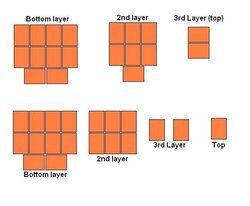should be seen as merely an "initial views" kind of post. reading too much into this would be like giving too much credit to somebody's first impressions of a stove they've never used before.
First test (Moisture content).
I placed the brick into the oven at 230F for about 12 hours and then weighed it. It had dropped from a total of 30oz to 28oz. I baked it for another 8 hours. Same weight. so we'll assume that the bricks are at least 6% MCwb or 7%MCdb, really dry either way you look at it.
Second Test (expansion).
I then placed the brick back into the oven at 450 for about 3 hours. I could tell I was loosing some volatiles, but that was irrelevant for what I was looking for. The heat did seem to cause the brick to break free along some compression seams (i don't know a better way to label it), but held together fairly solidly. I did not take measurements, but i think it's safe to guess that it grew about 5% along each axis. Not much, but noteworthy. Assuming that actual burning would be necessary to validate the minimal growth, I tossed it into my hot firebox and let it burn. It did grow some more in there, I'd say 10-15% along each axis, but as it burned some mass was burned off and part of that growth was ash left just attached, but not solid mass. (Like, if I pulled the brick out and blew the ash off of it, it would no longer be 10-15% larger than it was, but more like the 5% I initially saw.)
Third Test (Burning)
In order to maximize the burn time of these bricks I thought a completely flat top burning down would keep the lower bricks from burning, but I was too chicken to make a perfect "rectangular prism" because it would have taken more than one package (minus that one brick for testing)
So, I made three layers in something of a pyramid (See the first arrangement below). I had cleaned out the coals and ashes from the stove so as to be able to tell how much ash these produce, so I planned on starting this fire top down by placing some big coals on the top two bricks. Perhaps the stove had cooled too much to ignite this way, but I was completely unsuccessful in getting it to light like that. SO, I proceeded to arrange a few bricks inside to make a little "house" for the coals on the top. This way did seem to work much better, but I found out quickly that having a roaring fire on the top surface of the exposed bricks was insufficient to carry the draw when I shut the door (even with the primary wide open). I eventually gave up and place ONE split of pine (approximately 16" long and what would equal 1/4 of an 8" diameter round) on the two bricks that sat out front on the lowest level. this one log completely changed the burn characteristics of the entire load. Within a minute I had every exposed surface glowing (but not open flames) and the split itself was flaming. As I shut it down I noticed some good secondaries rolling at the top.
The overall burn time of this load probably came out near 8 hours WITH that split mixed in. From the doghouse it ate a tunnel straight through the middle of the pyramid an as that tunnel completely burned the pyramid in half, the burn efficiency dropped significantly and I had to mess with the primary air several times through the nite. This morning it was easy to restart the fire from the crumbling, yet glowing bricks that were left.
SO: my overall impression is that the natural cavities and overlapping logs that are in a normal fire facilitate a good long term fire with flames. With these bricks it is very difficult to burn them in a geometric pattern with few spaces. I guess one could equate this method to trying to get one huge chunk of dry firewood to burn top down. it just isn't going to work well.
I think that these bricks would be better off tossed all willy-nilly in there, but I think it's pretty safe to assume that you can get 8 hours of meaningful heat from them, but it takes fiddling with the air to do it.
These definitely seem like they would be appropriate to supplement with wet cordwood, or used as several bricks at a time on top of hot coals, but systematically packing the stove with them doesn't seem to be conducive to getting long even burns like I've been able to do with cordwood. As I said before, though, this is preliminary. I'd like to try to master it before I condemn them for being a good complete substitute for cordwood (burningwise only, i'll not get into financial feasibility or the benefits of storage, availability and mess)
edit: forgot to add the picture:



